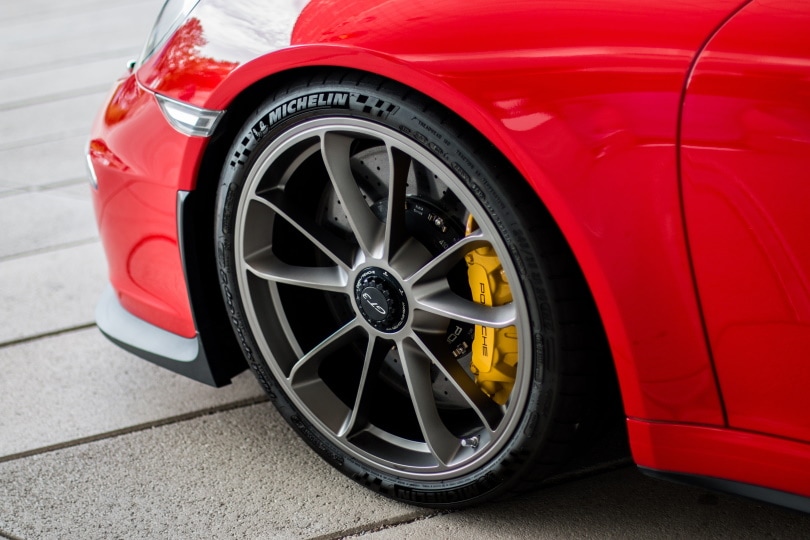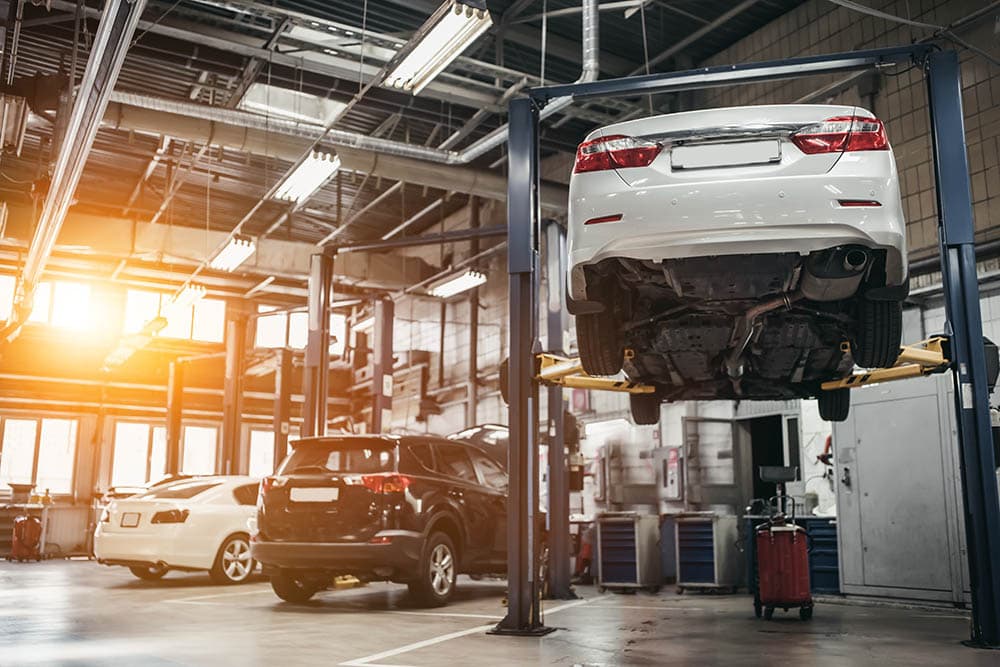What Is an Airbag Suspension System? Pros, Cons, Uses, & FAQ
-
- Last updated:

It’s rarely one of the first specs new car shoppers focus on, but an airbag suspension system can greatly benefit any driver. Air suspensions change the game when trailers and high payloads are part of the daily drive, and they’re equally effective at optimizing highway and off-road driving.
By replacing traditional coil systems with a dynamic air suspension, you can adjust your ride for any situation. Let’s explore what an airbag suspension system involves and how it’s superior to traditional suspension designs.

How Does It Work?
An airbag suspension system is a replacement for standard coil or leaf suspensions with inflatable rubber bellows. Bellows have several layers of reinforcement and cords to improve elasticity and stability. Pressurized air pumps into or out of the individual air springs to reach and maintain the desired suspension the user sets.
- Computer to direct the system to add or release air to each air spring
- Pressurized air reservoir
- Compressor to supply air
- Valve blocks and lines to send air to individual springs
- Height sensors at each air spring to monitor the height
- Desiccant filter to keep the system dry
The air supply unit (the compressor) draws in outside air and pressurizes it to about 150 PSI or higher. It sends air to the reservoir, a holding tank to supply on-demand air to the four air springs.
A control module monitors each air spring against the specified air pressure it sets. If you change the settings or the pressure isn’t correct, it tells the compressor and strut solenoids to adjust the air levels.

What Are the Different Types of Airbag Suspension Systems?
Like a coil-over suspension, the air spring sits over the shock absorber to create an air strut. OEM air springs are available, as are aftermarket options from a growing number of suppliers such as Air Lift, Ride-Rite, and X2.
Aftermarket vs. OEM Airbag Suspension
Today’s aftermarket bellows are relatively simple to fit into place on most cars, often replacing the factory shocks in the same location. A ride height controller is usually available as a built-in panel, remote control, or smartphone app. Many high-performance and affordable options are available, but there are some inherent drawbacks to an aftermarket system.
Storage is one obvious disadvantage. OEM air suspension components are integral to the design, so they don’t sacrifice usable space. By contrast, aftermarket compressors and reservoirs often have to sit in the trunk or back seat.
Aftermarket systems are also often lower quality than OEM parts because they don’t have to meet the same design standards. Many aftermarket suspensions use standard parts without regard for the application. They may work on a large truck but not a smaller car. A more rigid air suspension will downgrade the ride quality from OEM springs and likely cause more repair problems.
High-end OEM airbag suspension can also adjust their dampers as needed on the road. They use numerous sensors in their electronically controlled air suspension (ECAS) system to monitor road conditions. Aftermarket solutions often only have a manual soft-firm dampening switch you set before hitting the road.

Convoluted vs. Rolling Lobe Bellows
The bellows that make up the spring are available in two general varieties: convoluted and rolling lobe. A convoluted air spring looks like a stack of 2–3 donut-shaped bellows that flatten as they deflate. A rolling lobe (or rolling sleeve) suspension uses a single bladder that cascades around its bottom ring as it deflates.
Convoluted systems typically aren’t as tunable as a rolling lobe. The trade-off is that they allow for more flexibility and better load handling. Rolling lobe springs take up less space, making them ideal for smaller vehicles.
Open System vs. Closed System
Airbag suspensions are available in open or closed systems. The difference relates to how the air spring releases air. In an open system, a valve in the spring releases air to the outside. By contrast, a closed system contains pressurized air by using a mechanism to send air from the spring back to the reservoir.
Closed systems have several advantages over open systems. Since they don’t expel air, they’re much quieter. Public transit buses make loud hissing noises as they lower at curbs because of their open-system air suspensions. A closed system will also generally be more efficient and offer better responsiveness.
Where Is It Used?
The trucking industry has used air suspension for several decades, but it has reached a broader consumer market over the last two. Show car enthusiasts use airbag suspension kits to drop their cars to new lows. Meanwhile, truck drivers are using them to push the limits of performance, and even race cars are using them more. As technology improves, its application will become more commonplace.
Air suspension systems have been around since the early 1900s. As with many iconic staples in the modern automotive industry, the airbag suspension system owes much of its prominence to WWII. Engineers fitted artillery trucks with air suspension to manage the ride height under extreme loads.
Airbag suspensions entered the consumer market in the 1950s in hybrid systems alongside coils. These were particularly popular on the stock racing circuit and became an optional feature for some brands. In the 1960s, it started to become standard on select luxury vehicles.

The system took a giant leap forward in the 1990s with the advent of an electronic-controlled air suspension (ECAS) system. Mercedes offered a system using an ECAS with adaptive dampers, allowing each corner to automatically the ride height.
The 2000s saw several updates to air suspensions as luxury manufacturers began to add the technology into their lines. Today, most luxury SUVs (and many luxury sedans) incorporate some form of air suspension. The adaptive damping they provide gives drivers a range of comfort options.
Advantages of an Airbag Suspension System
While you may be able to feel the difference that air suspension makes with a heavy load, anyone can enjoy the improved ride they provides. Adjustability is a distinct element of modern air suspension systems. Drivers can change the height as they see fit for convenience, performance, and aesthetics.
At the same time, sensors maintain ride height and handling in the face of changing conditions. It will instantly adapt as you add more weight, whether it’s picking up some friends in your car or putting several kitchen appliances in your truck.
An airbag system creates less noise and vibration than traditional suspensions. It puts less stress and wear on the components, affecting longevity. Cornering also becomes smoother with air suspension. Trailers and large trucks enjoy a more confident grip on the road with enhanced leveling.
On pickups and other heavy load-carrying vehicles, airbag suspension makes a massive difference. When weighed down, the sensors will identify the unleveled suspension. They’ll increase the air in the individual springs as necessary and raise the pickup to the appropriate height. You won’t feel the weight as much, and the ride quality will improve significantly.
Lowering the car also makes it easier to enter and exit, making it ideal for large trucks. Meanwhile, raising the height helps with off-roading as it improves approach, break-over, and departure angles. On the highway, lowering the car will upgrade aerodynamics for fuel efficiency.

Disadvantages of an Airbag Suspension System
Despite the ride enhancements of an airbag suspension system, it also has notable drawbacks compared to coil and leaf suspensions.
Right out of the box, installation is a significant drawback. Installation is not for novices. It requires running lines from the compressor and opening ports throughout the vehicle, so you need advanced knowledge of suspension systems and the appropriate tools for working on your car.
Some glaring disadvantages of air suspension systems are that they’re heavy and powered, two traits that combine to affect fuel economy. They also cost more in initial price and repairs, and overall they are a more expensive system to maintain.
With a complex system like an air suspension, there’s more room for failure relative to non-mechanized coil or leaf systems. Air leaks in the bellows, lines, or fittings are rare but also a constant concern and can cause the compressor to fail. Breakdown in one component can impact the entire system, leading to expensive repairs.

Frequently Asked Questions (FAQs)
Can Airbag Suspensions Work with Lift Kits?
Airbag suspensions can work with some lift kits to provide adjustability at an elevated standard height. It’s more common to see this on trucks, and some manufacturers make lift kits for people looking to keep their OEM air suspension.
How Much Do Airbag Suspension Kits Cost?
Airbag suspension kits come in a broad range of complexity and cost. Simple airbag helpers to augment your suspension may cost less than $100. Entry-level complete kits will only cost a few hundred dollars. Meanwhile, high-end performance kits will run $1,500–$8,000 before installation.


Conclusion
Airbag suspension has been around for almost a century, but only recently have we seen its advantages for everyday drivers. Making the change from coils to airbags can help you even out payloads and optimize ride comfort no matter the conditions.
Despite the benefits, not all airbag suspension kits work the same way, nor are they simple replacements for a stock suspension. Making the change without the proper knowledge could reduce your car’s performance. Before making the jump, do your research and work with a professional to ensure your long-term satisfaction.
Featured Image Credit: ilmarinfoto, Shutterstock
Contents

